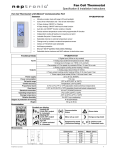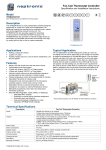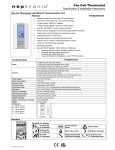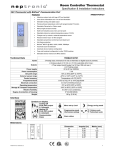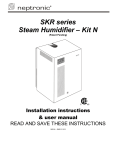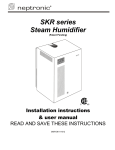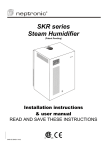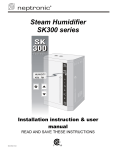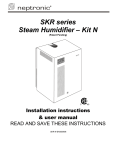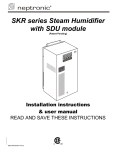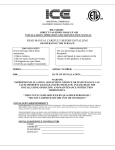Download BACnet TFHB24F3XYZ2 Technical data
Transcript
Fan Coil Thermostat Specification & Installation Instructions Fan Coil Thermostat with BACnet Communication Port ® Features: • • • • • • • • • • • • • TFHB24F3XYZ2 Attractive modern look with large LCD and backlight Icons driven information and 1 line of text information 2 Pipes Analog, ON/OFF or Floating or 4 Pipes Analog, ON/OFF with local re-heat function Auto fan and ON/OFF function enable or disable Internal humidity sensor and dehumidification sequence (compensated by auto-activation of the reheat output) Precise achieve temperature control with programmable PI function Independent cooling & heating no occupancy set point Lockable Set point / Control mode Change over by contact or external temperature sensor Celsius or Fahrenheit scale selectable Anti-freeze protection ® BACnet MS/TP @ 9600, 19200, 38400, 76800bps Selectable device Instance and MAC Address via technician menu Technical Data TFHB24F3XYZ2 1 Digital input (24Vac or dry contact) 1 Analog input (external temperature sensor 10Kohms) 1 Analog input (change over 10Kohms or dry contact) 1 Fan analog or 3 Fan speed dry contracts 24Vac, 1A max 3A in-rush 2 Analog outputs (cooling and/or heating 0-10Vdc) 1 Analog output (local reheat 0-10Vdc) 2 Triacs output (cooling and/or heating) 24Vac, 0.3A max fused / triac 1 Triacs output (local reheat) 24Vac, 0.3A max fused / triac 22 to 26Vac 50/60Hz 1 VA max Temperature: 10ºC to 40ºC [50ºF to 104ºF], Humidity: 10 to 65%RH Temperature: ±0.4ºC [0.8ºF], Humidity: ±3.5% 0.5ºC to 5ºC [1ºF to 10ºF] adjustable (heat/cool/reheat independent) 0.3ºC to 5ºC [0.6ºF to 10ºF] adjustable (heat/cool/reheat independent) 0.8 mm2 [18 AWG] minimum 0ºC to 50ºC [32ºF to 122ºF] -30ºC to 50ºC [-22ºF to 122ºF] 5 to 95% non condensing IP 30 (EN 60529) 160 g. [0.36 lb] Inputs Outputs Power supply Power consumption Set point range Control accuracy Proportional band Dead band Electrical connection Operating temperature Storage temperature Relative Humidity Degree of protection of housing Weight Presentation Symbols on display V MAX .. HR . ,. V MIN VDC AM PM SEC %RH C F Cooling ON 33,66,100% output A: Automatic Heating ON 33,66,100% output A: Automatic Fan ON 3rd speed activated A: Automatic Communication Status Alarm status Menu set-up Lock Energy saving mode Programming mode (Technician setting) %RH Humidity Dehumidification ON Celsius scale Cor F ºC: ºF: Fahrenheit scale Percentage of humidity Dimensions B Dimension A B C D E E D A TFHB24F3XYZ2.doc/100217 C Inches 2.85 4.85 1.00 2.36 3.27 Metric (mm) 73 123 24 60 83 1 TFHB24F3XYZ2 Specification & Installation Instructions Mounting Instructions A B C D E CAUTION: Risk of malfunction. Remove power prior to separate thermostat cover from its base. A. Remove the screw (captive) holding the base and the front cover of the thermostat. B. Lift the front cover of the thermostat to separate it from the base. C. Pull wire through the base hole. D. Secure the base to the wall using wall anchors and screws (supplied). Make the appropriate connections. E. Mount the control module on the base and secure using the screw. Terminal Description 2 Pipe Terminals 1 2 3 4 5 6 7 8 9 TB1 10 Fan option Common 24 Vac Common Triac Triac output 1 (TO1) Floating output 1 Triac output 2 (TO2) Triac output 3 (TO3) Reheat Common Relay Digital output 1 (DO1) Digital output 2 (DO2) Digital output 3 (DO3) / Analog Fan Speed (AO4) Occupancy Sensor (DI1) External Temp. Sensor (AI1) External Changeover (AI2) Analog output 1 (AO1) Analog output 2 (AO2) Analog output 3 (AO3) Reheat A+ Communication Bport RS-485 11 12 13 14 15 16 17 18 4 Pipe Terminals 1 2 3 4 5 6 7 8 9 TB1 10 Fan analog 1 spd Low Common 24 Vac Common Triac Triac output 1 (TO1) Floating Triac output 2 (TO2) output 1 Triac output 3 (TO3) Reheat Common Relay Digital output 1 (DO1) Digital output 2 (DO2) Digital output 3 (DO3) / Analog Fan Speed (AO4) Occupancy Sensor (DI1) Ext. Temp Sensor (AI1) External Changeover (AI2) Analog output 1 (AO1) Analog output 2 (AO2) Analog output 3 (AO3) Reheat A+ Communication port RS-485 B- Fan analog 1 spd Low Low Floating analog 1 spd 2 spd 3 spd Common 24 Vac Common Triac 2 Pipe floating (close) 2 Pipe floating (open) Local reheat (optional) (on/off or pulse) Common Relay High High Med Fan analog 1 spd Low Low Occupancy Sensor (optional) External Temp. Sensor (optional) External Changeover Local reheat analog (optional) Occupancy Sensor (optional) External Temp. Sensor (optional) External Changeover Local reheat analog (optional) BACnet BACnet BACnet Common 24 Vac Common Triac Local reheat (optional) (on/off or pulse) Common Relay - Low On/Off analog 1 spd 2 spd 3 spd Common 24 Vac Common Triac 2 Pipe on/off Local reheat (optional) (on/off or pulse) Common Relay High High Med Occupancy Sensor (optional) External Temp. Sensor (optional) External Changeover 2 Pipe analog Local reheat analog (optional) Cool & Heat Analog analog 1 spd 2 spd 3 spd Fan option 11 12 13 14 15 16 17 18 Analog analog 1 spd 2 spd 3 spd Common 24 Vac Common Triac Local reheat (optional) (on/off or pulse) Common Relay High High Med - Fan analog 1 spd Cool Analog-Heat On/Off or pulse Cool & Heat On/Off analog 1 spd 2 spd 3 spd analog 1 spd 2 spd 3 spd Common 24 Vac Common Triac 4 Pipe on/off cool 4 Pipe (on/off or pulse) heat Local reheat (optional) (on/off or pulse) Common Relay High High Med Low Low - Fan analog 1 spd Common 24 Vac Common Triac 4 Pipe (on/off or pulse) heat Local reheat (optional) (on/off or pulse) Common Relay High High Med Low Low - Fan analog 1 spd Cool On/Off - Heat Analog analog 1 spd 2 spd 3 spd Common 24 Vac Common Triac 4 Pipe on/off cool Local reheat (optional) (on/off or pulse) Common Relay High High Med - Low Low - Fan analog 1 spd High High Med Low Low Occupancy Sensor (optional) External Temp. Sensor (optional) 4 Pipe analog cool 4 Pipe analog heat Local reheat analog (optional) Occupancy Sensor (optional) External Temp. Sensor (optional) Local reheat analog (optional) Occupancy Sensor (optional) External Temp. Sensor (optional) 4 Pipe analog cool Local reheat analog (optional) Occupancy Sensor (optional) External Temp. Sensor (optional) 4 Pipe analog heat Local reheat analog (optional) BACnet BACnet BACnet BACnet Settings on PC Board Triac Output Signal Selection (JP1) JP1 Triac output signal selector 24VAC COM JP1 JP1 TB1 24VAC 1 JP2 2 5 6 JP2 8 Mode selector JP4 Fan output signal selector 1 2 3 ON Temperature sensor Dip switch 9 10 11 12 13 14 15 16 17 18 PGM RUN 7 JP3 Jumper (JP1) on COMMON TRIAC: All triac output signals are linked to common triac. Digital Output Signal Selection (JP2) 4 Connecting strip TB1 3 Digital output signal selector COM Jumper (JP1) on 24Vac: All triac output signal is linked to 24 vac. 24VAC JP2 COM Jumper (JP2) on 24Vac: All digital output signal is linked to 24Vac. Jumper (JP2) on COMMON RELAY: All digital output signals are linked to common relay. Fan Output Signal Selection (JP4) Jumper (JP4) on top: DO3 Pin 10 of TB1 is set to be digital output AO4 signal (DO3). JP4 Jumper (JP4) on bottom: DO3 Pin 10 of TB1 is set to be analog output AO4 signal (AO4). Mode Selection (JP3) Jumper (JP3) on RUN: RUN Thermostat is in operation mode. PGM Thermostat must be set in this mode to operate properly. If not locked, set point, control mode and speed fan (Heating & Cooling ON, Cooling only ON or Heating only ON) may be modified by end user. JP3 JP3 RUN PGM Jumper (JP3) on PGM: Thermostat is set in Programming mode. Refer to following section about all settings description BACnet Dip Switch (DS1) - Optional Pull up 120 ohm termination (Last node) Pull down JP4 ON 1 2 3 2 TFHB24F3XYZ2 Specification & Installation Instructions Programming Mode When in this mode this symbol is displayed. Please press on button to advance to the next program function, press on button to return to preceding stage and press on button or to change value. You can leave the programming mode at any time, changed values will be recorded. Step Display Description Values Internal temperature sensor Calibration: Display shows “inside temper sensor offset” and temperature read by internal temperature sensor. Range : 10 to 40ºC [50 to 104ºF] You can adjust the calibration of the sensor by comparison with a known (max. offset ± 5 ºC) 1 thermometer. For example if thermostat has been installed in an area Increment: 0.1ºC [0.2ºF] where temperature is slightly different than the room typical temperature (thermostat place right under the air diffuser). C 2 C Minimum set point: Display shows “adjust minimum user setpnt” and the minimum set point temperature. Please select the desired minimum set point temperature. The minimum value is restricted by the maximum value. (step #3) 3 C 5 6 Maximum set point: Display shows “adjust maximum user setpnt” and the maximum set point Maximum range: temperature. 10 to 40ºC [50 to 104ºF] Please select the desired maximum set point temperature. Increment: 0.5ºC [1ºF] Default value: 30ºC [86ºF] The maximum value is restricted by the minimum value. (step #2) Locking the set point: Display shows “user setpnt locked” and the status of the function. You can lock or unlock the set point adjustment by end user. If locked, “yes” and lock symbol will appear. 4 C Minimum range: 10 to 40ºC [50 to 104ºF] Increment: 0.5ºC [1ºF] Default value: 15ºC [59ºF] Adjust internal set point: Display shows “adjust intern setpnt” and the set point temperature. Select the desired set point temperature; this one should be within the temperature range. Lock symbol will appear if the set point was locked at the previous step. Default value: Unlocked (NO) Set point range: 10 to 40ºC [50 to 104ºF] Increment: 0.5ºC [1ºF] Default value: 22ºC [72ºF] Set point value is restricted by the minimum and maximum value. (step #2 & 3) Adjust the control mode: Display shows “adjust temper control mode”. Cooling and heating symbols are also displayed. Select which control mode you want to authorize: Automatic cooling and heating, cooling or heating, heating only or cooling only. If you want to authorize this entire mode, choose Automatic mode. Default value: Automatic cooling and heating 7 8 Set On/Off function enable or disable: Display shows “enable on off control mode”. You can enable or disable the On/Off function in control mode adjustment by end user. Set 2 pipe or 4 pipe: Display shows “select 2 pipe 4 pipe system”. Cooling and heating symbols are also displayed. Select which number of pipes you want to use: 2 pipes or 4 pipes. Default value: Enable (YES) Default value: 2 pipe If you have selected the 4 pipes, go directly to step #15. 3 TFHB24F3XYZ2 Step Display Specification & Installation Instructions Description Set signal for 2 pipe system: Display shows “select 2 pipe signal”. Cooling and heating symbols are also displayed. Select which signal output you want for your 2 pipe system. You can choose analog, on/off or floating output. If you select analog, AO1 will be set in automatic heat/cool change over. If you select on/off, TO1 will be set in automatic heat/cool change over. If you select floating, TO1 will be set close and TO2 open. If you have selected analog signal, go directly to step #11. If you have selected on/off signal, go directly to step #13. Set floating time: Display shows “set floating time in seconds” and the floating time value (in seconds). Please select desired value of the floating time signal. 9 10 Go to step #13. Minimum voltage of the analog output: Display shows “min vdc analog output” and the value of the minimum voltage of the analog ramp. Please select the desired value of the minimum voltage of the analog ramp. (This is the “zero” value) 11 Values Default value: Analog Range: 15 to 250 sec. Increment: 5 sec. Default value: 100 sec. Range: 0.0 to 10.0 Volt Increment: 0.1 Volt Default value: 0.0 Volt The minimum value is restricted by the maximum value. (step #11) Maximum voltage of the analog output: Display shows “max vdc analog output” and the value of the minimum voltage of the analog ramp. Please select the desired value of the maximum voltage of the analog ramp. (This is the “span” value) 12 Range: 0.0 to 10.0 Volt Increment: 0.1 Volt Default value: 10.0 Volt The maximum value is restricted by the minimum value. (step #10) 13 14 15 16 C Change over sensor selection: Display shows “Ch over temper sensor”. Please select which sensor is rewired to the analog input: SENs (external change over sensor), NoCl (change over contact normally cool) or NoHt (change over contact normally heat). When normally cool “NoCL” is selected, if contact is closed heating mode will be activated, if contact is opened cooling mode will be activated. When normally heat “NoHt” is selected, if contact is closed cooling mode will be activated, if contact is opened heating mode will be activated. When change over external sensor “SENs” is selected, heating mode will be activated when temperature read by external sensor is above the Change Over Set Point temperature, and cooling mode will be activated when temperature read by external sensor is under, see step #14. If “SENs” is not selected, go directly to step #21. Change over set point temperature: (If ‘’SENs’’ has been selected at step #13) Display shows “Ch over setpnt temper” and the change over set point temperature. Please select the change over set point temperature. Note: heating mode will be activated when temperature read by external sensor is above the change over set point temperature, and cooling mode will be activated when temperature read by external sensor is under. Go to step #21. Set signal for 4 pipe heating system: (If ‘’4P’’ has been selected at step #8) Display shows “select 4 pipe heating signal”. Heating symbols is also displayed. Select which heating signal output you want for your 4 pipe system. You can choose analog, on/off or pulse output. If you select analog, AO2 will be set in heating. If you select on/off or pulse, TO2 will be set in heating. If you have selected on/off or pulse signal, go directly to step #18. Minimum voltage of the heating output: Display shows “min vdc analog output heating” and the value of the minimum voltage of the heating ramp. Please select the desired value of the minimum voltage of the heating ramp. (This is the “zero” value) Default value: SENs Range: 10 to 40ºC [50 to 104ºF] Increment: 0.5ºC [1ºF] Default value: 24ºC [82ºF] Default value: Analog Range: 0.0 to 10.0 Volt Increment: 0.1 Volt Default value: 0.0 Volt The minimum value is restricted by the maximum value. (step #17) 4 TFHB24F3XYZ2 Step Display 17 Specification & Installation Instructions Description Maximum voltage of the heating output: Display shows “max vdc analog output heating” and the value of the minimum voltage of the heating ramp. Please select the desired value of the maximum voltage of the heating ramp. (This is the “span” value) Values Range: 0.0 to 10.0 Volt Increment: 0.1 Volt Default value: 10.0 Volt The maximum value is restricted by the minimum value. (step #16) Set signal for 4 pipe cooling system: (If ‘’4P’’ has been selected at step #8) Display shows “select 4 pipe cooling signal”. Cooling symbols is also displayed. Select which cooling signal output you want for your 4 pipe system. You can choose analog or on/off output. If you select analog, AO1 will be set in cooling. If you select on/off, TO1 will be set in cooling. If you have selected on/off signal, go directly to step #21. Minimum voltage of the cooling output: Display shows “min vdc analog output cooling” and the value of the minimum voltage of the cooling ramp. Please select the desired value of the minimum voltage of the cooling ramp. (This is the “zero” value) 18 19 Default value: Analog Range: 0.0 to 10.0 Volt Increment: 0.1 Volt Default value: 0.0 Volt The minimum value is restricted by the maximum value. (step #20) Maximum voltage of the cooling output: Display shows “max vdc analog output cooling” and the value of the minimum voltage of the cooling ramp. Please select the desired value of the maximum voltage of the cooling ramp. (This is the “span” value) 20 Range: 0.0 to 10.0 Volt Increment: 0.1 Volt Default value: 10.0 Volt The maximum value is restricted by the minimum value. (step #19) Set local reheat signal Display shows “set local reheat signal”. Heating symbols is also displayed. Select which signal output you want for reheat. You can choose OFF (no signal selected), ANALOG heating only, ANALOG heating & fan, ON/OFF heating only, ON/OFF heating & fan, PULSE heating only, PULSE heating & fan output. 21 If you select analog (& fan), AO3 will be set in reheat. If you select on/off (& fan) or pulse (& fan), TO3 will be set in reheat. If you have selected analog (& fan) signal, go directly to step #22. If you have selected on/off (& fan) or pulse (& fan) signal, go directly to step #24. If you have selected OFF, go directly to step #26. Default value: Off Minimum voltage of the reheat output: Display shows “min vdc analog output reheat” and the value of the minimum voltage of the reheat ramp. Please select the desired value of the minimum voltage of the reheat ramp. (This is the “zero” value) 22 Range: 0.0 to 10.0 Volt Increment: 0.1 Volt Default value: 0.0 Volt The minimum value is restricted by the maximum value. (step #23) Maximum voltage of the reheat output: Display shows “max vdc analog output reheat” and the value of the minimum voltage of the reheat ramp. Please select the desired value of the maximum voltage of the reheat ramp. (This is the “span” value) 23 Range: 0.0 to 10.0 Volt Increment: 0.1 Volt Default value: 10.0 Volt The maximum value is restricted by the minimum value. (step #22) 24 C Reheat proportional band: Display shows “control ramp reheat” and the value of the reheat proportional band, heating symbol is also displayed. Please select the desired value of reheat proportional band. Proportional band range : 0.5 to 5.0ºC [1 to 10ºF] Increment: 0.5ºC [1ºF] Default value: 2.0ºC [4ºF] 5 TFHB24F3XYZ2 Step 25 26 27 28 29 Display Specification & Installation Instructions C Description Reheat dead band: Display shows “control dead band reheat” and the value of the reheat dead band, heating symbol is also displayed. Please select the desired value of reheat dead band. C Proportional band in heating: Display shows “control ramp HEATing” and the value of the heating proportional band, heating symbol is also displayed. Please select the desired value of heating proportional band. C Proportional band in cooling: Display shows “control ramp cooling” and the value of the cooling proportional band, cooling symbol is also displayed. Please select the desired value of cooling proportional band. C C Dead band in cooling: Display shows “control dead band cooling” and the value of the cooling dead band, cooling symbol is also displayed. Please select the desired value of cooling dead band. 30 31 Integration time factor setting: Display shows “adjust intgral time in seconds” and the time in seconds for the integration factor compensation. Please select the desired value of the integration factor compensation. 33 Dead band range : 0.3 to 5.0ºC [0.6 to 10.0ºF] Increment: 0.1ºC [0.2ºF] Default value: 0.3ºC [0.6ºF] Proportional band range : 0.5 to 5.0ºC [1 to 10ºF] Increment: 0.5ºC [1ºF] Default value: 2.0ºC [4ºF] Proportional band range : 0.5 to 5.0ºC [1 to 10ºF] Increment: 0.5ºC [1ºF] Default value: 2.0ºC [4ºF] Dead band in heating: Display shows “control dead band heating” and the value of the heating Dead band range : dead band, heating symbol is also displayed. 0.3 to 5.0ºC [0.6 to 10.0ºF] Please select the desired value of heating dead band. Increment: 0.1ºC [0.2ºF] Default value: 0.3ºC [0.6ºF] Anti-cycling delay cooling contact (protection for compressor): Display shows “cooling anti cycle minutes” and the value (in minutes) of the delay to activate / reactivate cooling contact. Please select the desired value of the delay cooling contact. 32 Values Dead band range : 0.3 to 5.0ºC [0.6 to 10.0ºF] Increment: 0.1ºC [0.2ºF] Default value: 0.3ºC [0.6ºF] Range: 0 to 15 min. Increment: 1 min. Default value: 2 min. Range: 0 to 250 seconds Increment: 5 seconds Default value: 0 seconds Fan damping factor setting: Display shows “adjust damping factor seconds” and the time in seconds for the damping factor which will slow down the effect in change Range: 0 to 10 seconds of demand for fan speed. Increment: 1 seconds Please select the desired value of the damping factor. Default value: 0 seconds Fan speed signal: Display shows “select fan speed signal” and the speed of the fan. Fan symbol is also displayed. Select which fan speed signal or quantity of contact you want: Analog signal, 1 speed, 2 speed or 3 speed. If you want to use 1, 2 or 3 fan contact, select speed desired and go directly to step #36. Default value: 3 fan speed contact 6 TFHB24F3XYZ2 Step Display Specification & Installation Instructions Description Minimum voltage of the fan output: Display shows “min vdc analog output fan” and the value of the minimum voltage of the fan ramp. Please select the desired value of the minimum voltage of the fan ramp. (This is the “zero” value) 34 Values Range: 0.0 to 10.0 Volt Increment: 0.1 Volt Default value: 0.0 Volt The minimum value is restricted by the maximum value. (step #35) Maximum voltage of the fan output: Display shows “max vdc analog output fan” and the value of the minimum voltage of the fan ramp. Please select the desired value of the maximum voltage of the fan ramp. (This is the “span” value) 35 Range: 0.0 to 10.0 Volt Increment: 0.1 Volt Default value: 10.0 Volt The maximum value is restricted by the minimum value. (step #34) Set fan speed automatic mode enable or disable: Display shows “enable fan auto mode”. Fan symbol is also displayed. You can enable or disable the Automatic mode adjustment by end user. 36 If you selected to disable the automatic mode, go directly to step #38. Time out fan contact: Display shows “fan auto timeout minutes” and the automatic shutoff delay value (in minutes) when there is no demand. Range: 0 to 15 min. Please select the desired value of the automatic shutoff delay. Increment: 1 min. Default value: 2 min. 37 38 39 Default value: Enable (YES) C External sensor selection: Display shows “extern sensor temper”. Please select which sensor is rewired to the analog input: OFF (input none rewired), t10.0 (external temperature sensor 10.0 KΩ) Default value: Off When nothing “OFF” is selected, the thermostat is controlled by is internal temperature sensor. When external sensor “t10.0” is selected, the thermostat is controlled by an external temperature sensor. If you have selected OFF, go directly to step #40. External temperature sensor Calibration: Display shows “extern temper sensor offset” and temperature read by external temperature sensor. Range: 0 to 50ºC [41 to 122.0ºF] If the sensor is not connected or short circuited, the display shows “Eror”. (max. offset ± 5 ºC) You can adjust the calibration of the external sensor by comparison with a Increment: 0.1ºC [0.2ºF] known thermometer. Occupancy contact: Display shows “Select occ contact”. Moon symbol is also displayed. You can choose NO (normally open) or NC (normally close) contact. 40 41 Default value: Normally open (NO) No occupancy derogation time : Display shows “no occ delay overide minutes” and the derogation time in minute. NSB symbol is also displayed. Range: 0 to 180 min. Please select the desired derogation time. Increment: 15 min. If no derogation time is desired select “0”. Default value: 120 min. 7 TFHB24F3XYZ2 Step 42 43 Display C C 44 %RH 45 %RH 46 Specification & Installation Instructions Description Heating Set point during no occupancy: Display shows “no occ heating setpnt” and the value of the heating set point temperature during no occupancy period. Moon and heating symbols are also displayed. Please select the heating set point temperature during no occupancy. The maximum value is restricted by the no occupancy cooling set point. (step # 43) Cooling set point during no occupancy: Display shows “no occ cooling setpnt” and the value of the cooling set point temperature during no occupancy period. Moon and cooling symbols are also displayed. Please select the cooling set point temperature during no occupancy. The minimum value is restricted by the no occupancy heating set point. (step # 42) Internal humidity sensor offset Calibration: Display shows “inside humidty sensor offset” and relative humidity percentage read by internal humidity sensor. Humidify symbol is also displayed. You can adjust the calibration of the sensor by comparison with a known humidistat. For example if humidistat has been installed in an area where humidity is slightly different than the room typical humidity (humidistat place right under the air diffuser). Humidity control ramp: Display shows “humidty control ramp” and the value of the humidity ramp. Humidify symbol is also displayed. Select the desired span for the humidify ramp. Communication bauds rate: Display shows “adjust comport bauds rate” and the value of the baud rate in kBds. Select the desired bauds for communication. Communication MSTP/Mac address: Display shows “adjust MSTP Mac address”. Select the desired MSTP/Mac for communication. 47 Values Range: 10.0 to 40.0ºC [50 to 104ºF] Increment: 0.5ºC [1ºF] Default value: 16.0ºC [61ºF] Range: 10.0 to 40.0ºC [50 to 104ºF] Increment: 0.5ºC [1ºF] Default value: 28.0ºC [82ºF] Range: 10 to 90%RH (max. offset ± 5%) Increment: 0.1%RH 0.0%RH no humidity sensor Set point range: 3 to 10%RH Increment: 0.5%RH Default value: 5.0%RH Range: 9600, 19200, 38400, 76800 Default value: 9.6 kBds Range: 0 to 254 Increment: 1 Default value: 1 Communication device instance: Display shows “adjust device instanc 0153000”. If you want to change the device, select “yes” and go to next step. 48 If you do not want to change the device, go directly to step #1. Communication device instance (cont’d): Display shows the device address value. You can modify the device address by incrementing or decrementing the 49 blinking digit with “∆” or “∇”buttons. To modify following digit on right , to return to digit on the left press . press Default value: no Range: 0 to 4194302 Increment: 1 by digit Default value: 0153000 8 TFHB24F3XYZ2 Step 50 Display Specification & Installation Instructions Description Enable or disable anti-freeze protection: Display shows “enable anti freeze protect”. You can enable or disable the Anti-freeze function. When enabled, if temperature drop to 4ºC [39ºF], heat and reheat will start even if thermostat is in OFF mode. Heat and reheat will stop when temperature reach 5ºC [41ºF]. Values Default value: Disable (NO) 9 TFHB24F3XYZ2 Operation Mode Step A Specification & Installation Instructions Description Display At powering up, thermostat will light display and activate all LCD segments during 2 seconds. Illuminating the LCD. To illuminate the LCD, you just have to push onto any of the 4 buttons. LCD will light for 4 seconds. Temperature display In operation mode, thermostat will automatically display the temperature reading for 8 seconds. Humidity reading will be displayed for 2 seconds. If “OFF”, “- - -” and alarm symbol are displayed, the temperature sensor is not connected or short circuited. C To change the scale between ºC and ºF, press on both ∆ and ∇ for 3 seconds. Temperature set point display and adjustment To display the set point, press two times on ∆ or ∇. Set point will be displayed during 3 seconds. B To adjust set point, press on ∆ or ∇ while the temperature set point is displayed. Note: If set point adjustment has been locked, C C %RH %RH symbol will be displayed. Humidity set point display and adjustment button for 5 seconds. When in this mode Humidity set point menu will be access by pushing “ADJUST HUMIDTY SETPNT” is displayed. Set point will be displayed during 5 seconds. C D To adjust set point, press on ∆ or ∇ while the humidity set point is displayed. If you press on button or , you will leave the humidity set point menu. Humidity display In operation mode, when humidity reading is displayed for 2 seconds, if “- - -” and alarm symbol are displayed, the humidity sensor is not connected or short circuited. No occupancy mode : When thermostat is in no occupancy mode, moon symbol is displayed, so set point for cooling and/or heating are increased as per the setting made in programming mode. If not locked, no occupancy mode can be derogated for a predetermined period by pressing onto any of the 3 buttons. During period of derogation the symbol will flash. If does not flash, the derogation period is finished or the no occupancy mode derogation has been locked in programming mode. Control mode selection : To change the control mode, press on can choose one of the following: E 9 9 9 9 C . Control mode will be displayed during 5 seconds. You Automatic Cooling or Heating Cooling and Heating OFF Cooling only Heating only Note: These selections can vary according to the choice made on steps #6 & #7. Fan speed mode selection: To change the fan speed mode, press on You can choose one of the following: F 9 9 9 9 . Fan speed mode will be displayed during 5 seconds. Automatic speed (if not disable in programming mode) Low speed Medium speed High speed Note: These selections can vary according to the choice made on step #33 & #36. Recycling at end of life ® At end of life, please return the thermostat to your Neptronic local distributor for recycling. If you need to find the nearest Neptronic authorized distributor, please consult www.neptronic.com. ® 10










